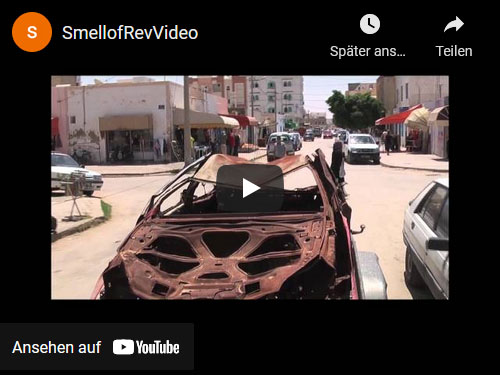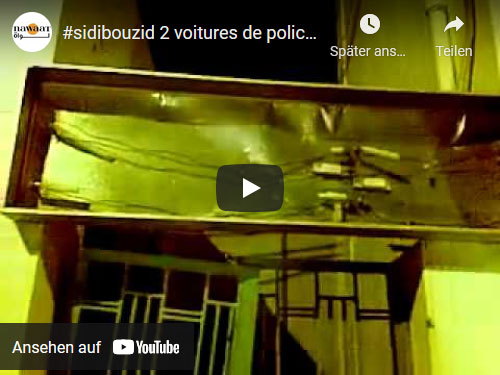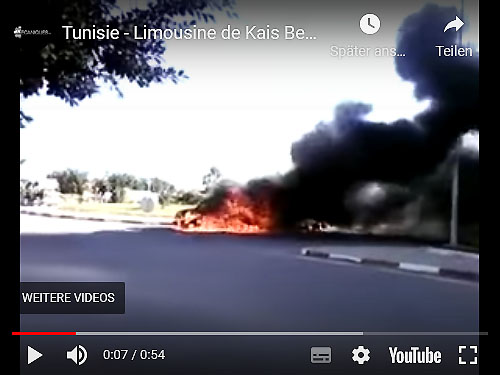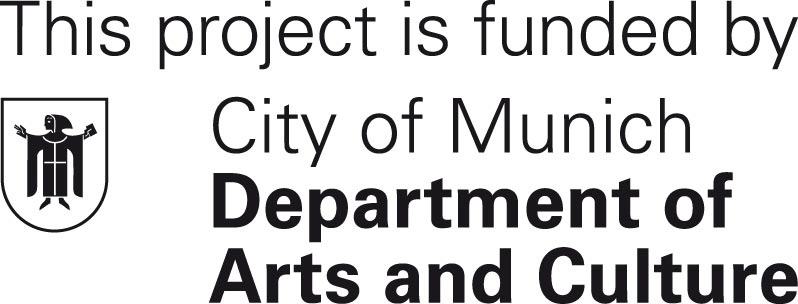Smell Of Revolution
Transport a Smell of Revolution
Recherche Tamar Sharabi
Im Januar 2011 zeigte die tunesische Jugend, dass auch die stabilsten politischen Systeme über Nacht zerbrechen können. Seitdem werden rund um den Globus Plätze besetzt, Zeltstädte errichtet und Straßenschlachten ausgetragen. Der öffentliche Raum wird eingenommen und politisiert. Das brennende Auto wird zur Ikone des Umbruchs.
Chrsitian Schnurer findet ein ausgebranntes Autowrack in Sidi Bouzid, Tunesien und setzt es unvermittelt in den Stadtraum Münchens. Das Wrack erfährt wird durch den Transport von Tunesien nach München eine Umwandlung. Das Souvenir der Revolution wirkt in den Flaniermeilen des “schönen Millionendorfs” deplaziert und konfrontiert die Öffentlichkeit mit einer Realität jenseits der Schlagzeilen. München scheint eine der letzten Inseln der Glückseeligen zu sein, auf der politische Langeweile herrscht, während die Empörten der Welt die etablierte Ordnung demontieren.
Das Privatauto des jungen Polizisten Ridha wird im Januar 2011 nach dem Sturz von Ben Ali vor der Polizeiwache von einer wütenden Menge angezündet. Ridha erzählt von seinem Verlust, seiner Verantwortung als Repräsentant des Staates und der Zwangsläufigkeit von Gewalt im revolutionären Umbruch. „Smell of Revolution“ stellt die Frage nach dem Sinn von Revolutionen, Heldentum und Destruktion des Status Quo.
Standort Maximilianster 20: 5. August bis 29. August
Standort Türkenstrasse 18: 29. August bis 20. September
4th Oct 2013
18th Sep 2013
Saturday September 21, 7pm - Halle6
Abschlußveranstaltung mit Videoscreening und Künstlergespräch mit Tamar Maya Sharabi und Christian Schnurer Sa. 21. September 19.00 Uhr Halle6, Dachauerstrasse 112 d, 80636 München, Tram 20/21 Haltestelle Leonrodplatz
7th Aug 2013
This is the reflection of a police officer whose personal car was burned outside the police station in Sidi Bouzid, Tunisia.
7th Aug 2013 | 1 note
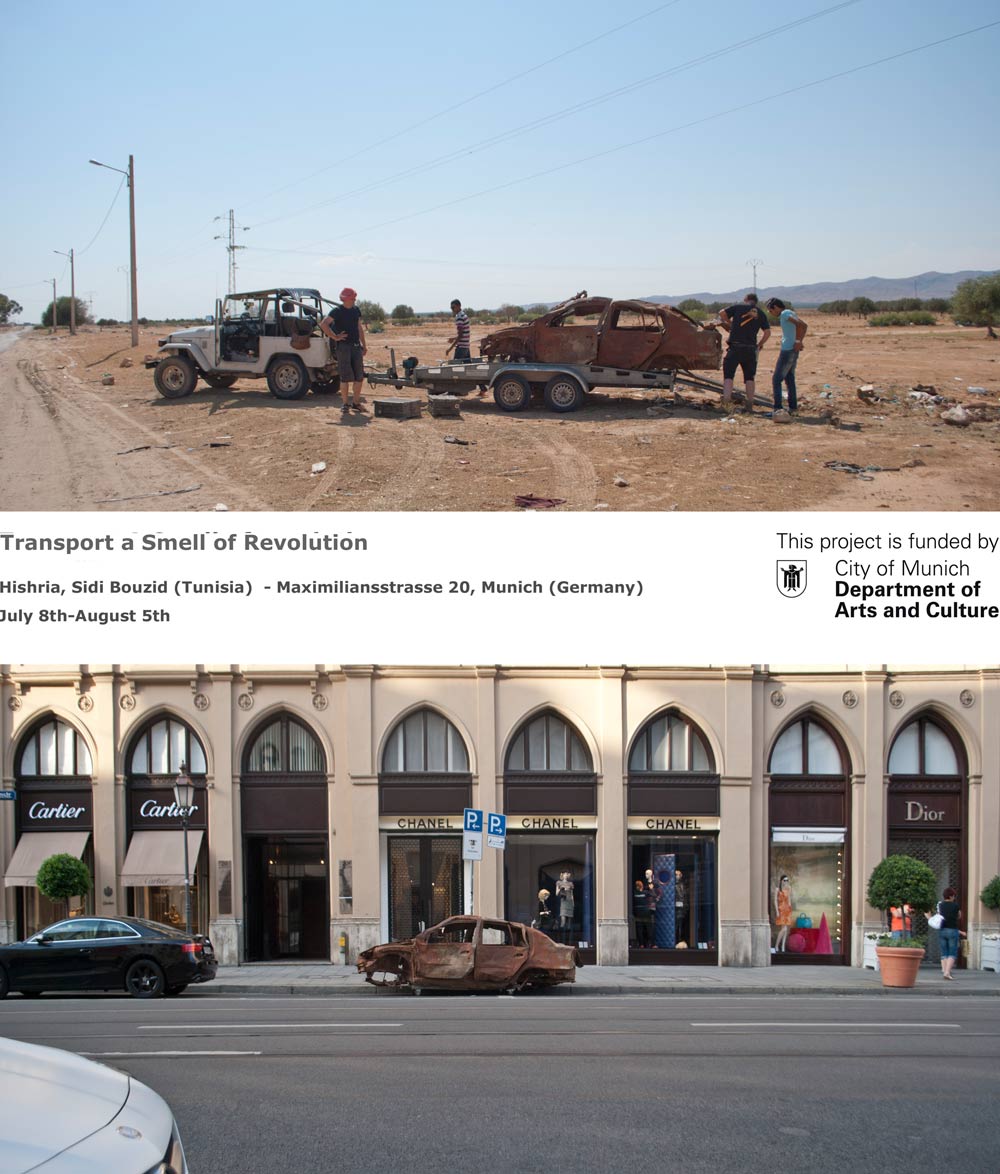
29th Jul 2013
“Smell of revolution“ is a artproject of Christian Schnurer and Tamar Maya Sharabi . They search a burned-out car wreck in order to bring it to the most fancy streets of Central Europe.
The ready made relic of the democratic “revolution” in Tunisia becomes a work of art through the process of reversing the export path. The path through public space.
In Munich, the object becomes surreal event - forming a maximum contrast to the environment and the destination for the cultured establishment. Unlike Berlin, Paris, London or Cairo cars burn very rare here.
The revolution is distant and strange. The realities of daily survival of systemic change and the ongoing struggle for a contract enabled constitution and personal freedom disappears.
24th Jul 2013
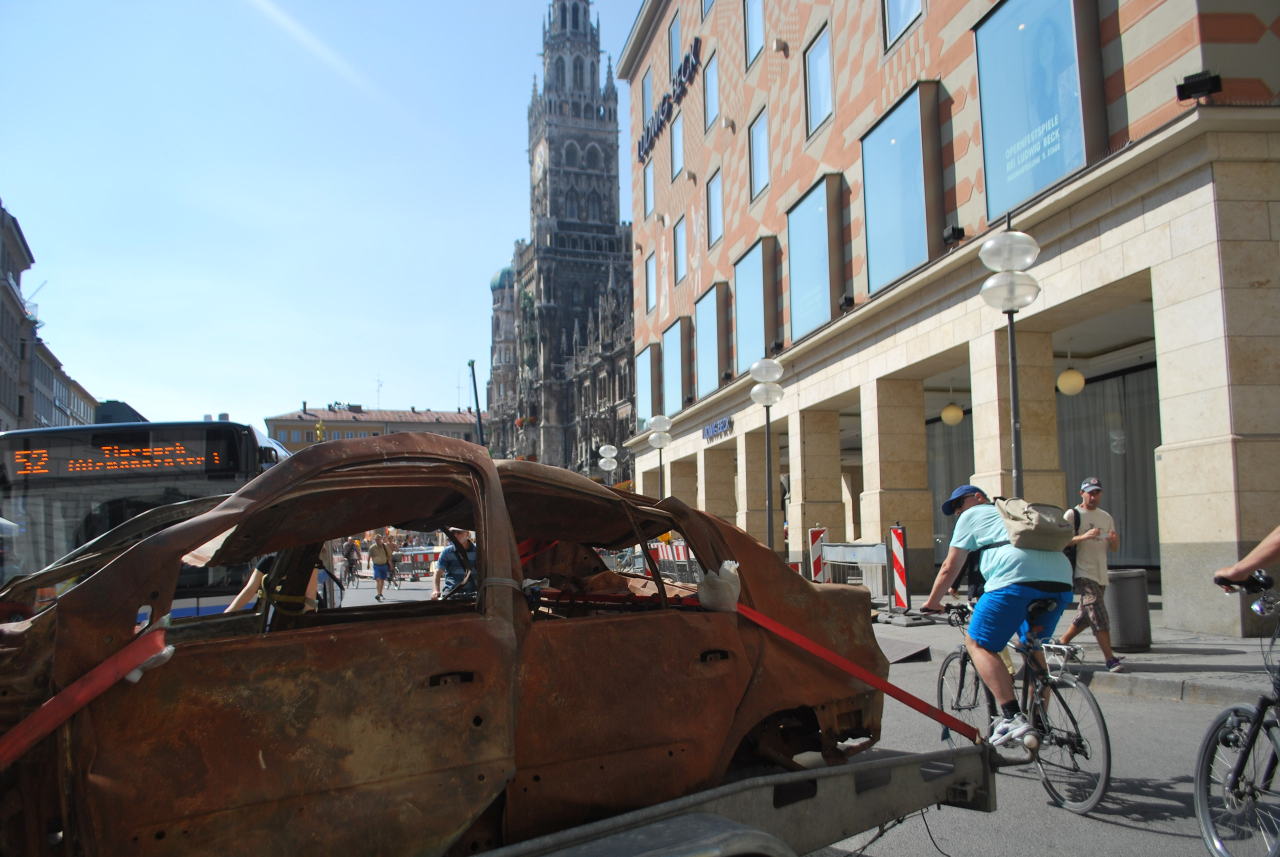
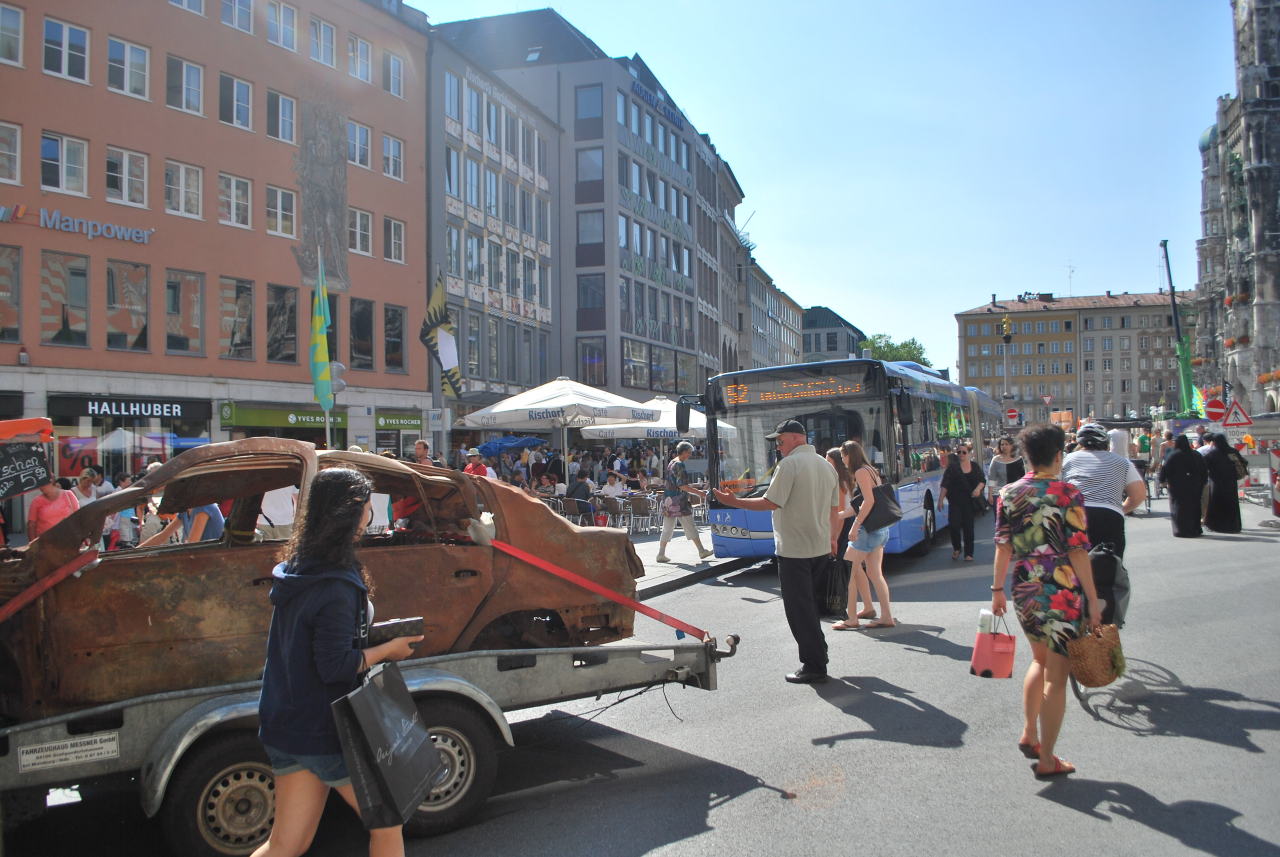
Reaching Munich 16.7.2013
24th Jul 2013
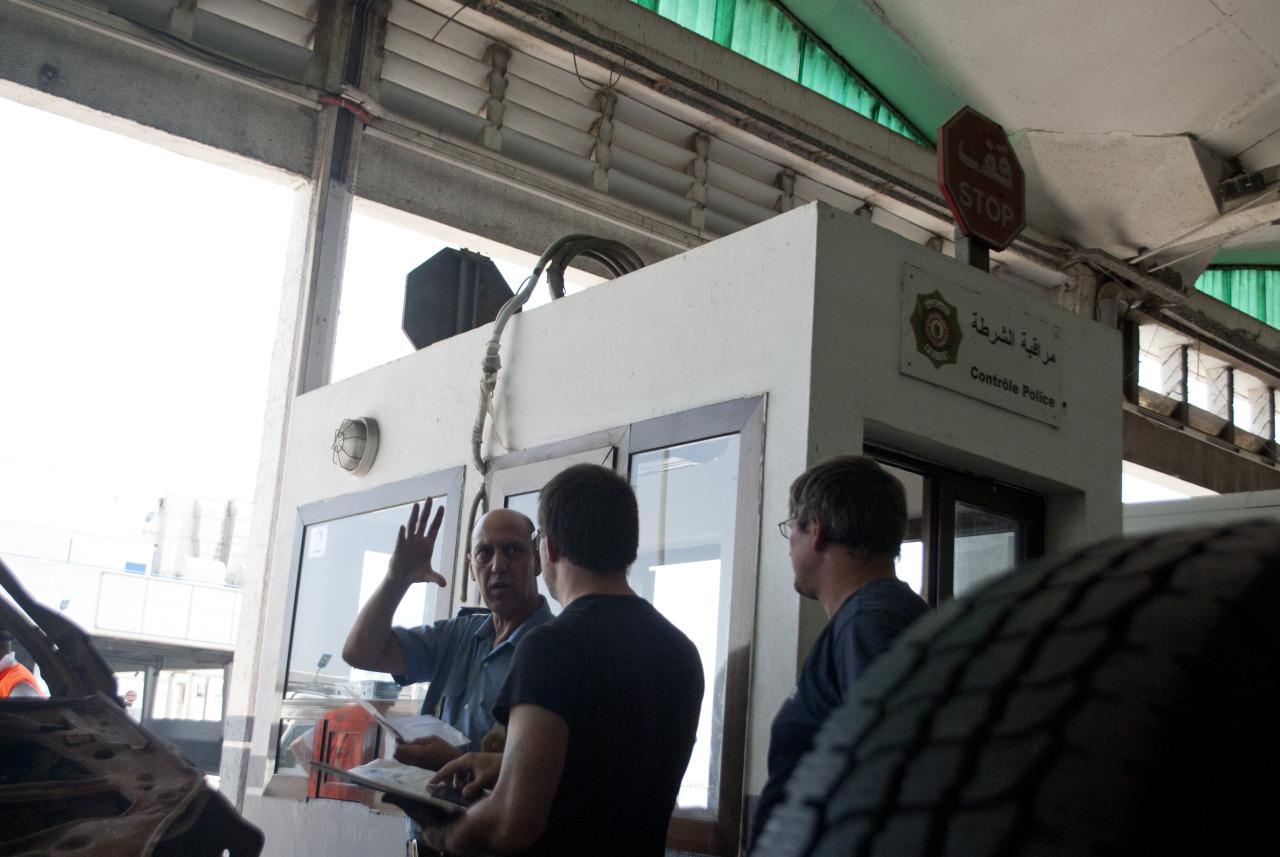
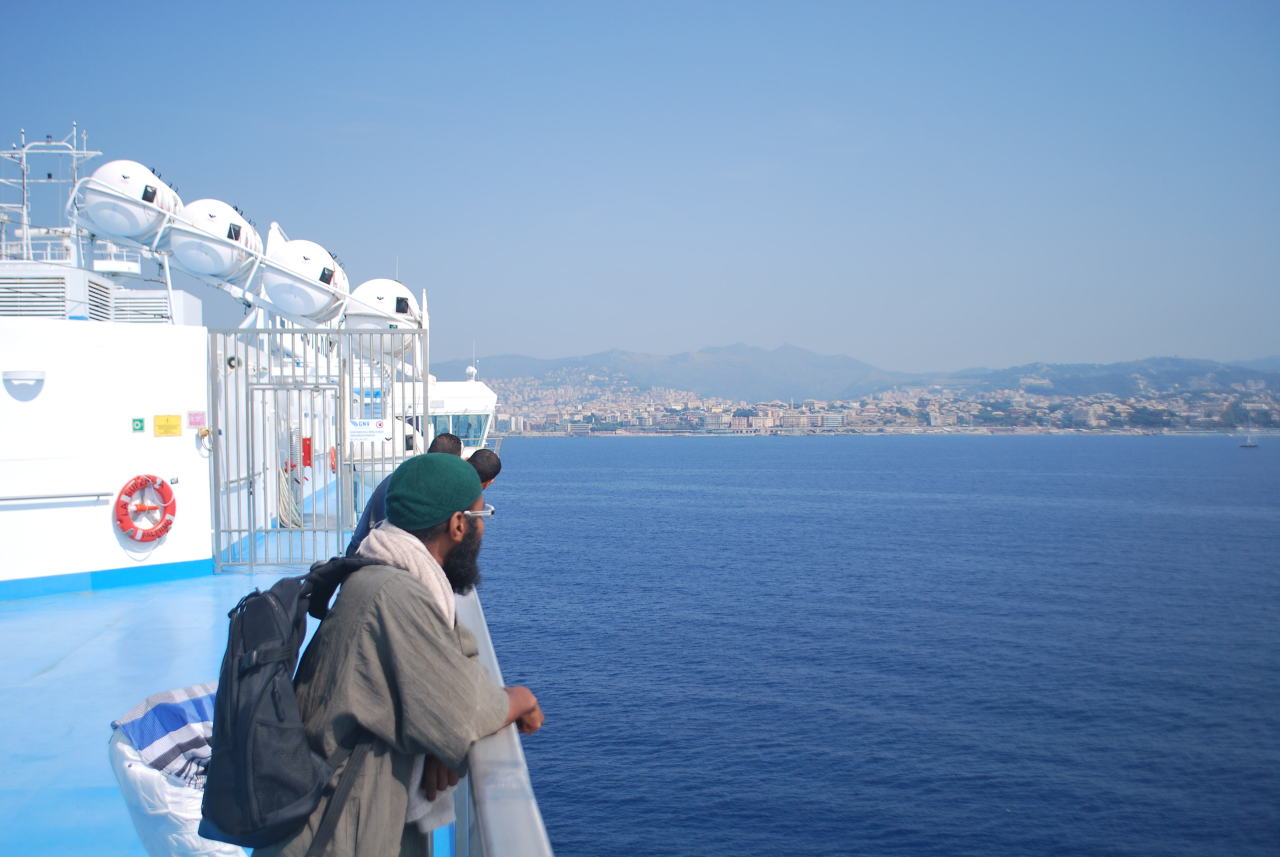
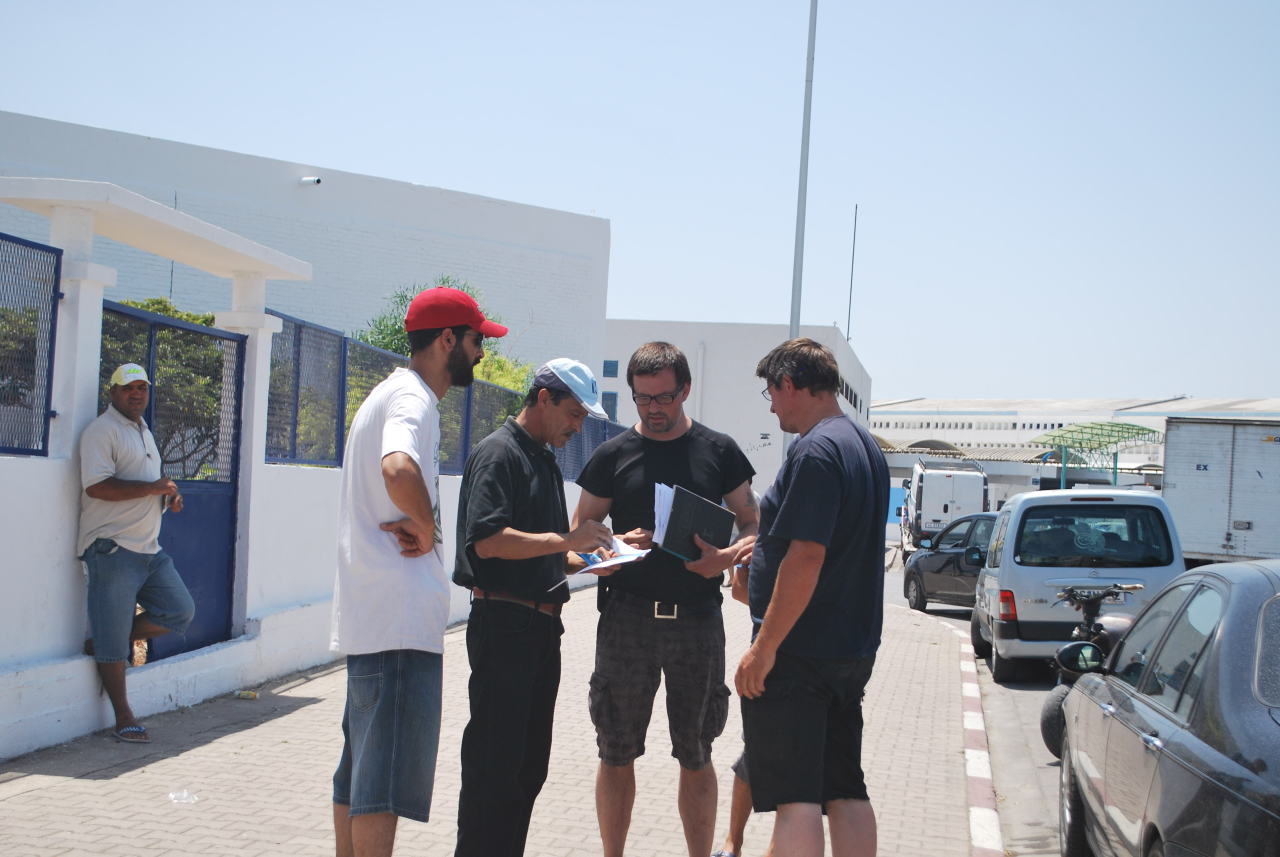
Leaving Tunisia to reach the promised Land 14.7.20013
24th Jul 2013
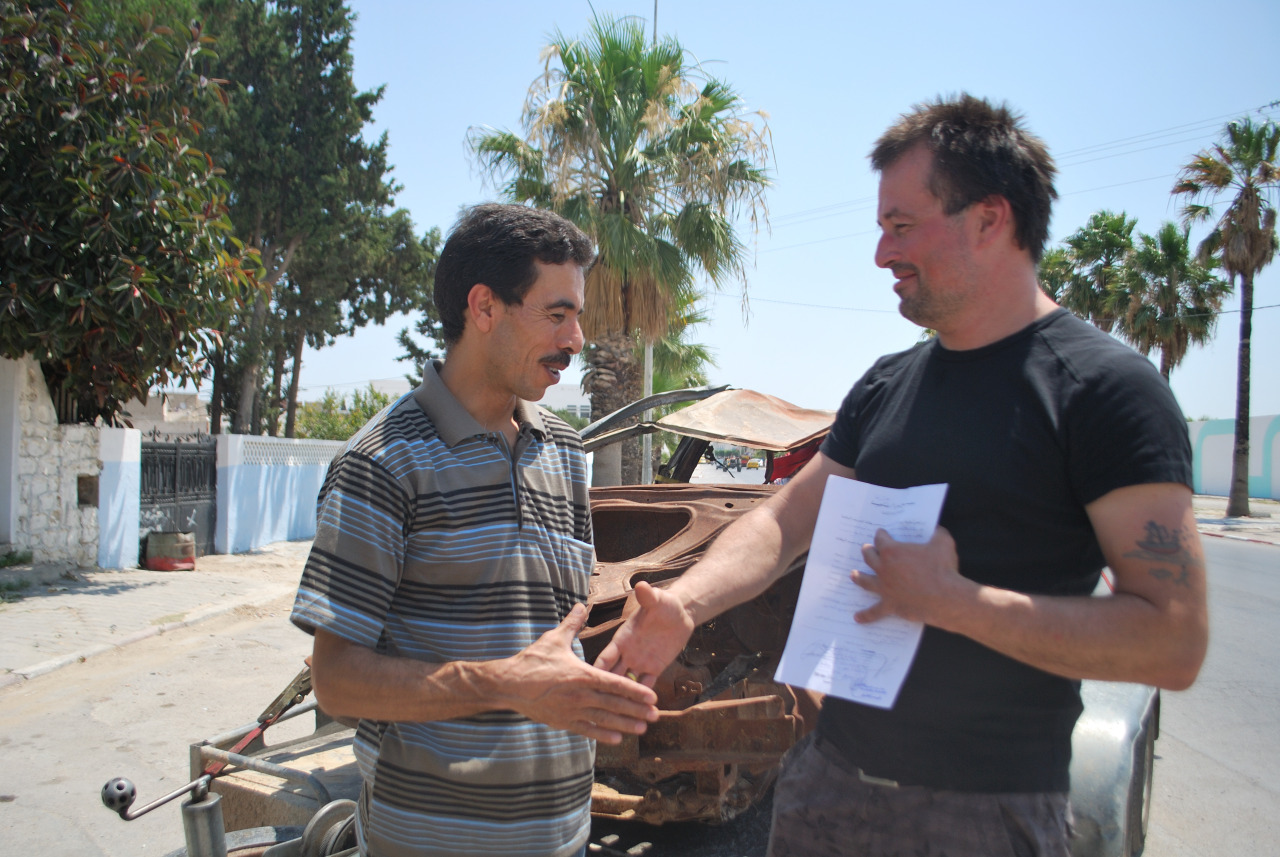
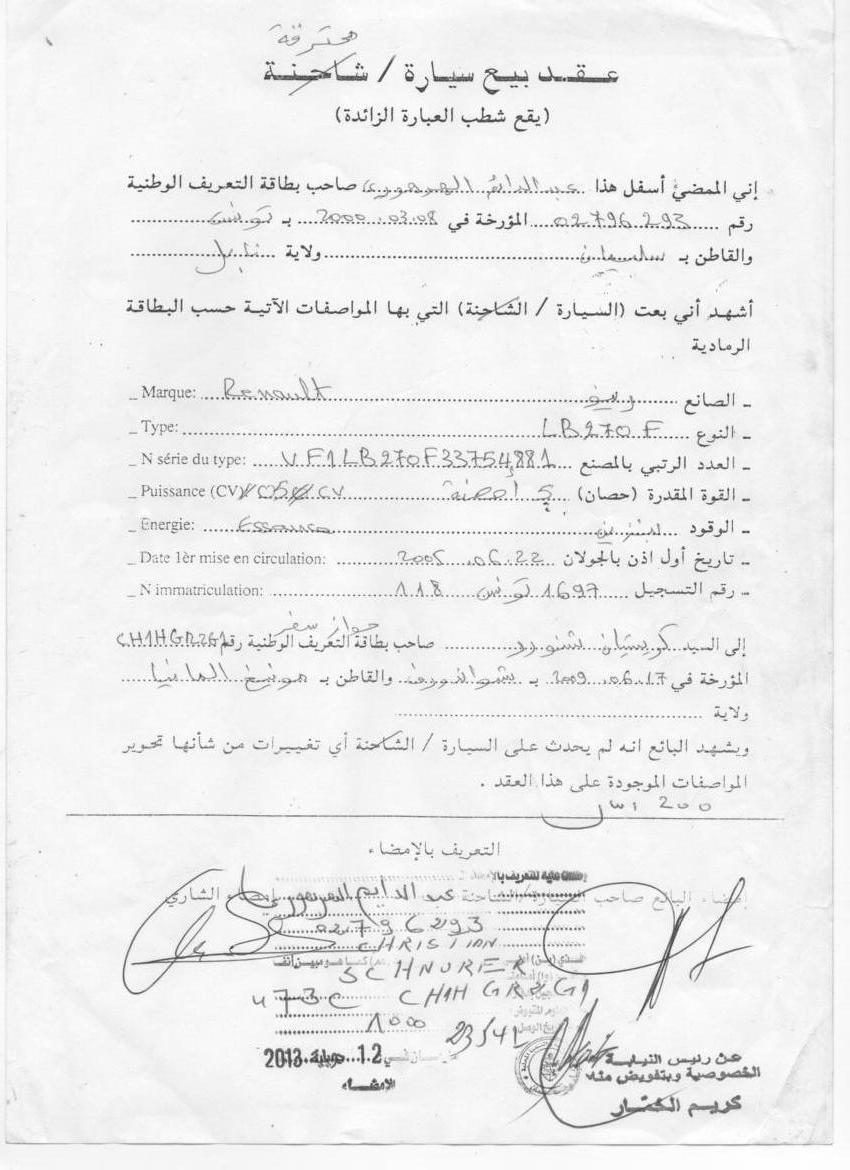
Making the contract with Abdeldaim 12.7.2013
24th Jul 2013
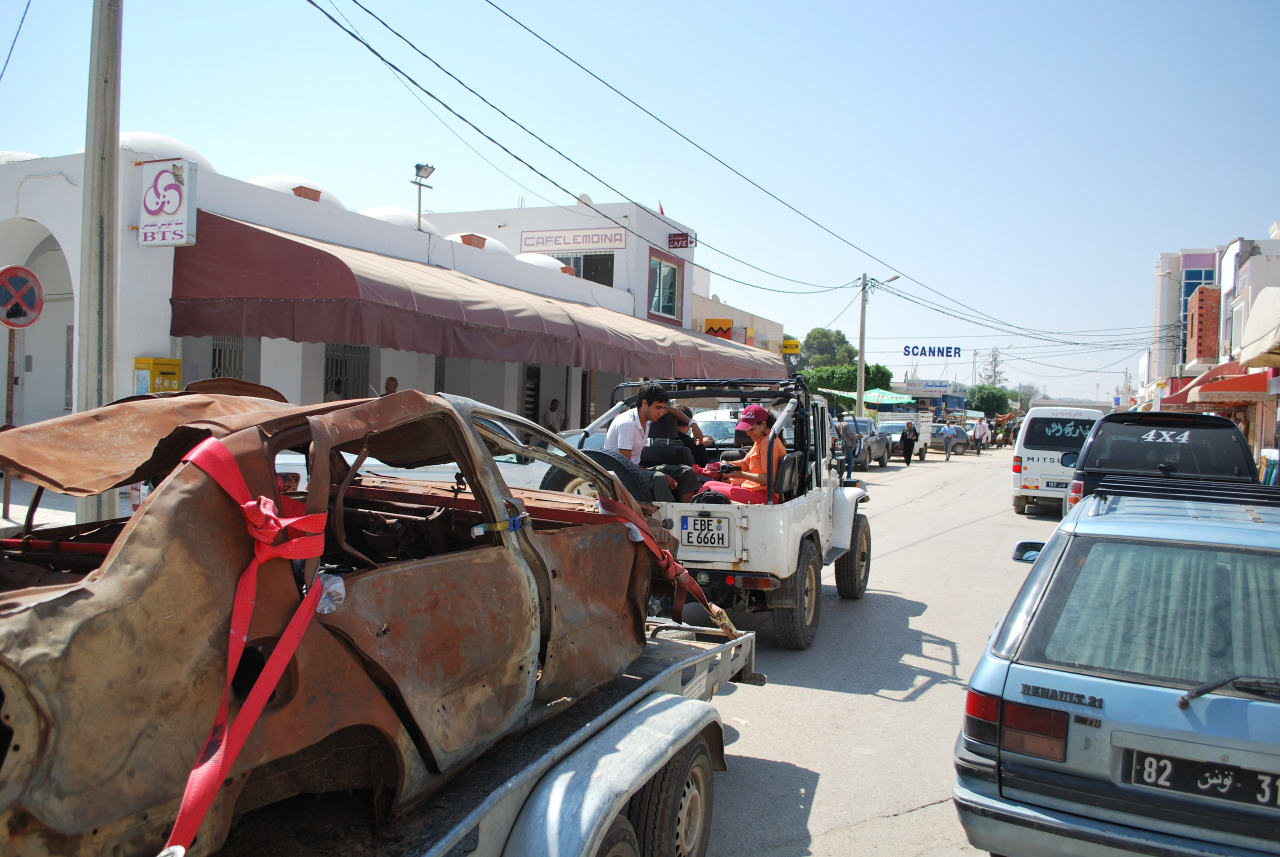
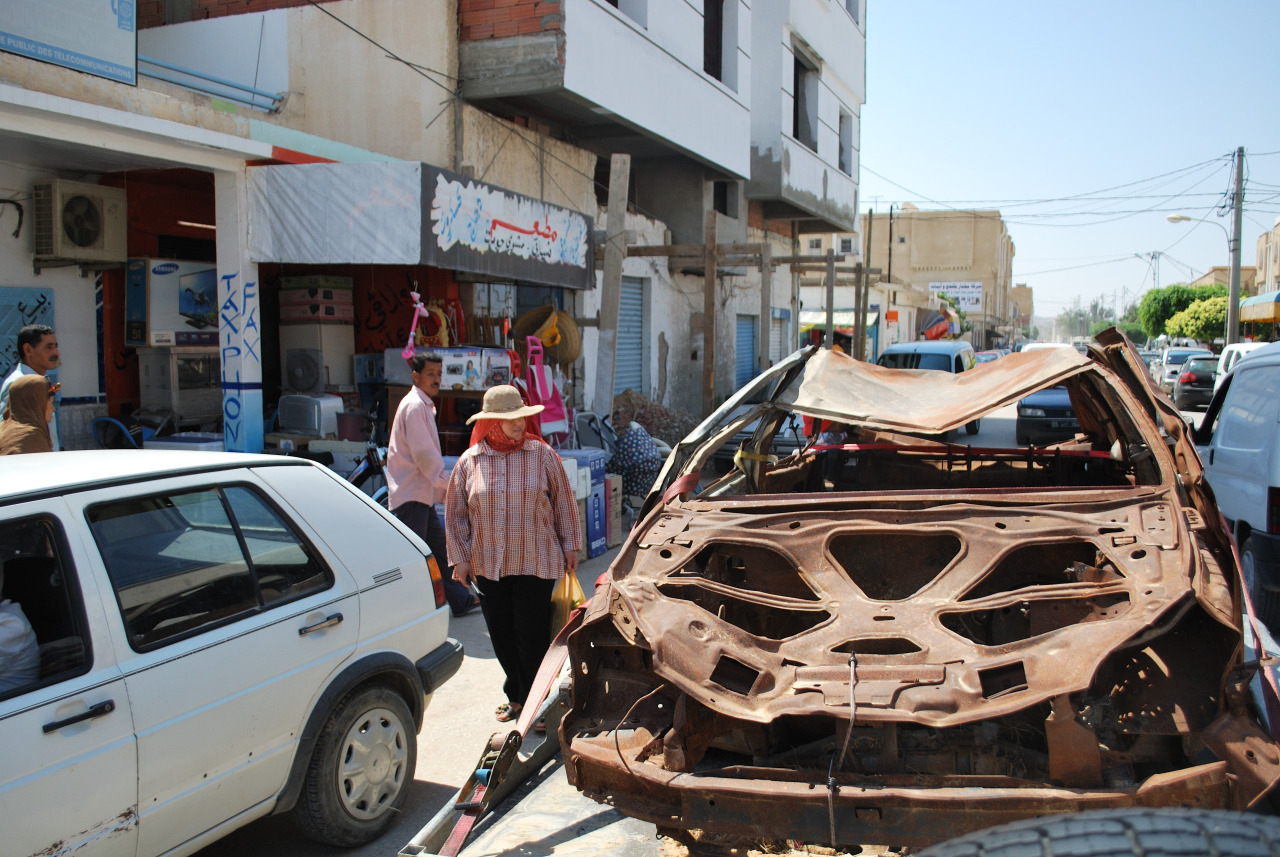
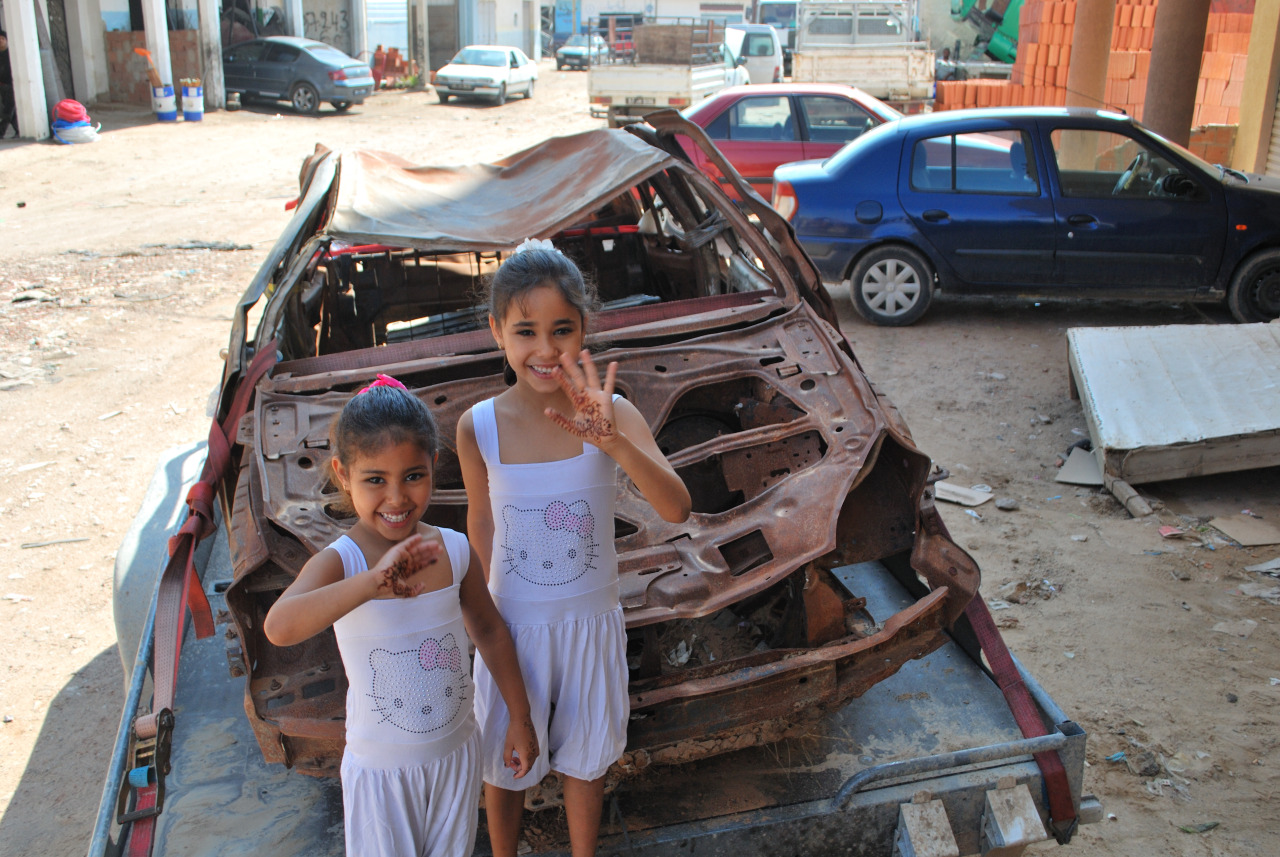
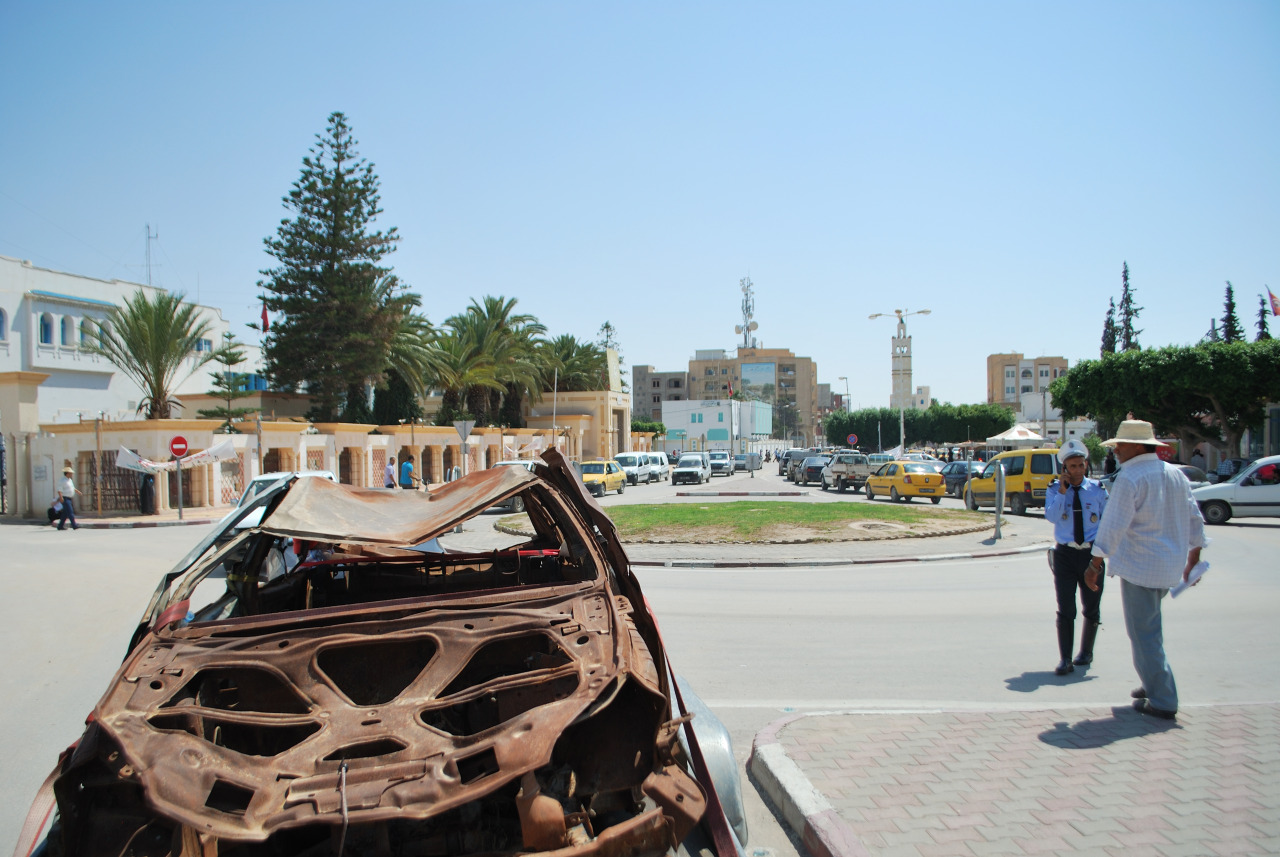
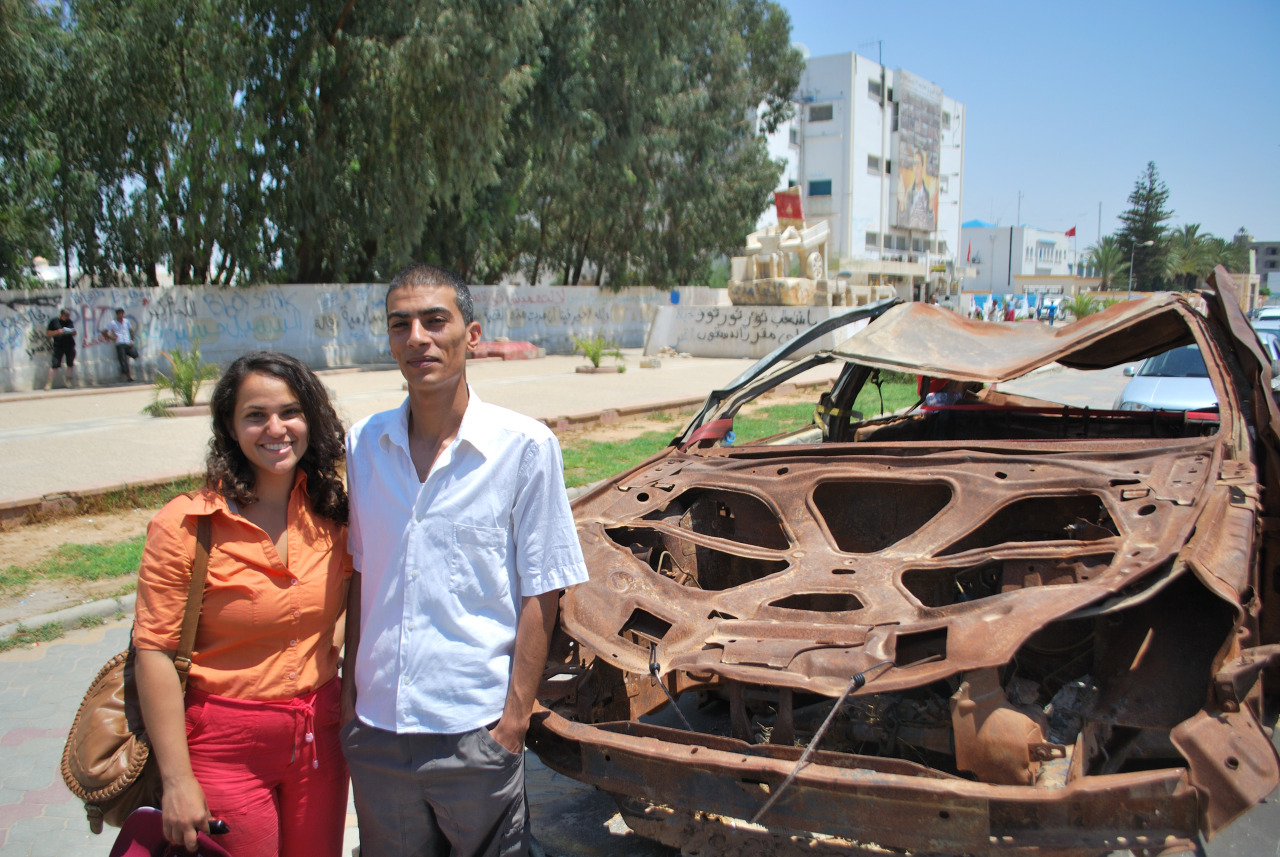
Sidi Bouzid Bastillon de la Revolution
24th Jul 2013
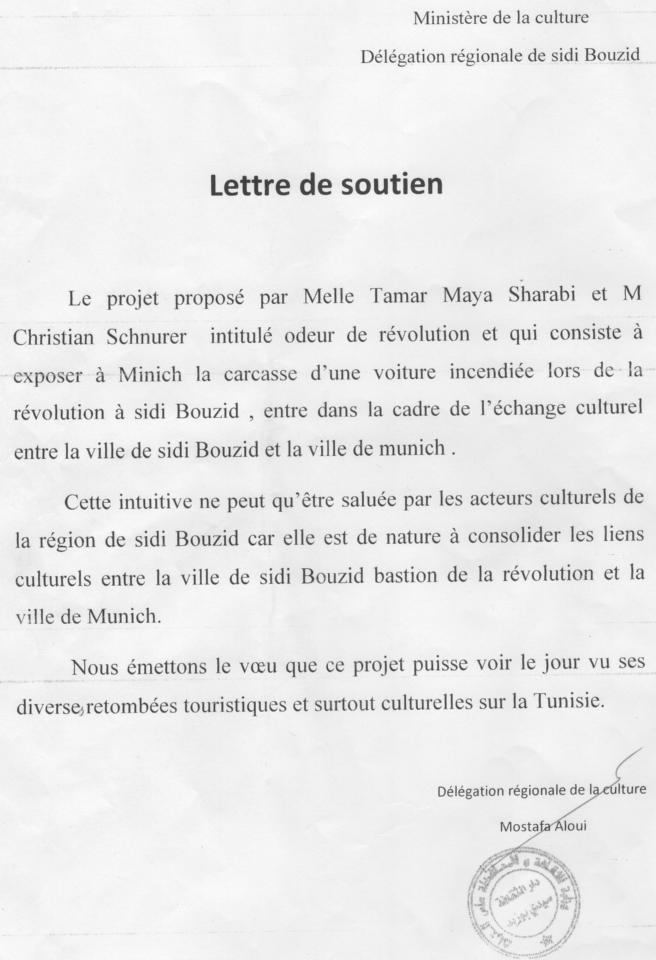
13th Jul 2013
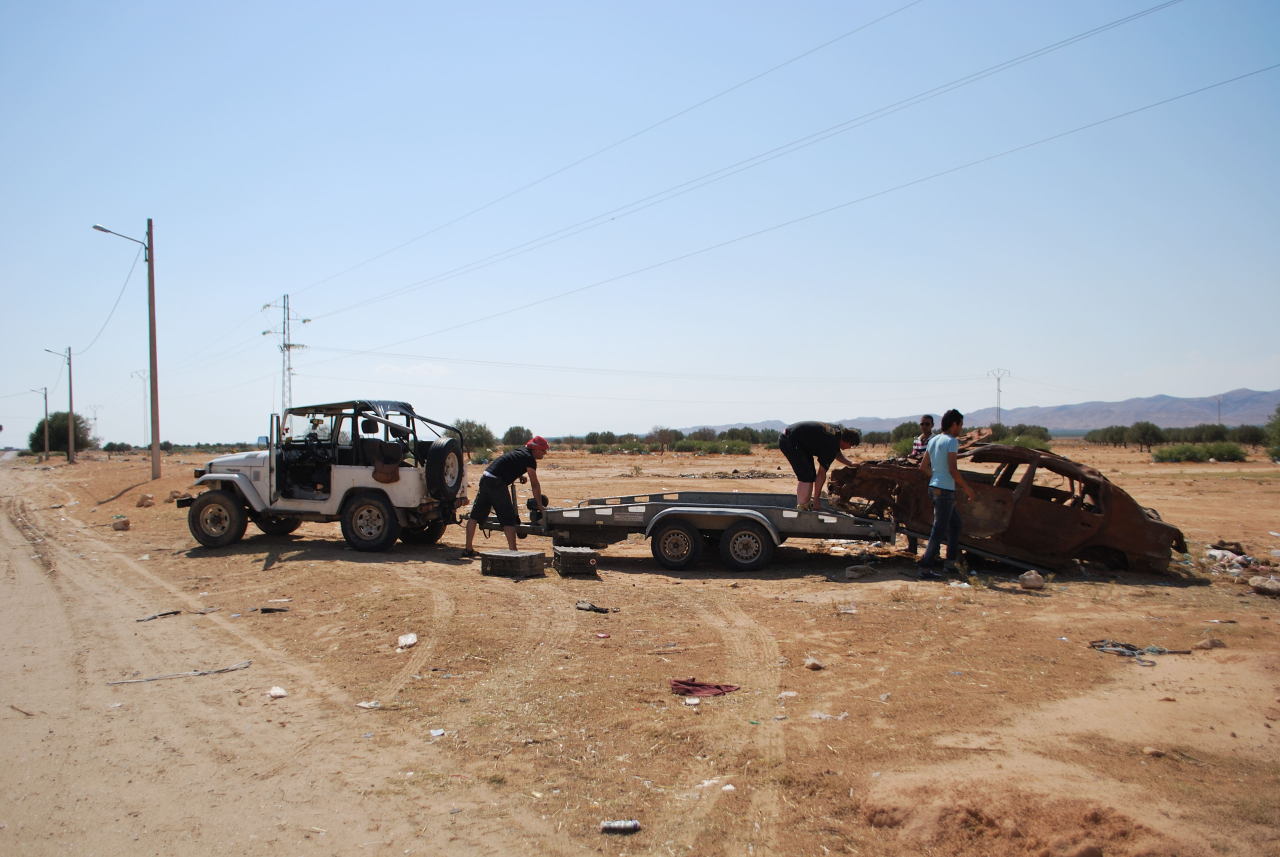
Loading in Hichria 10.7.2013
7th Jul 2013
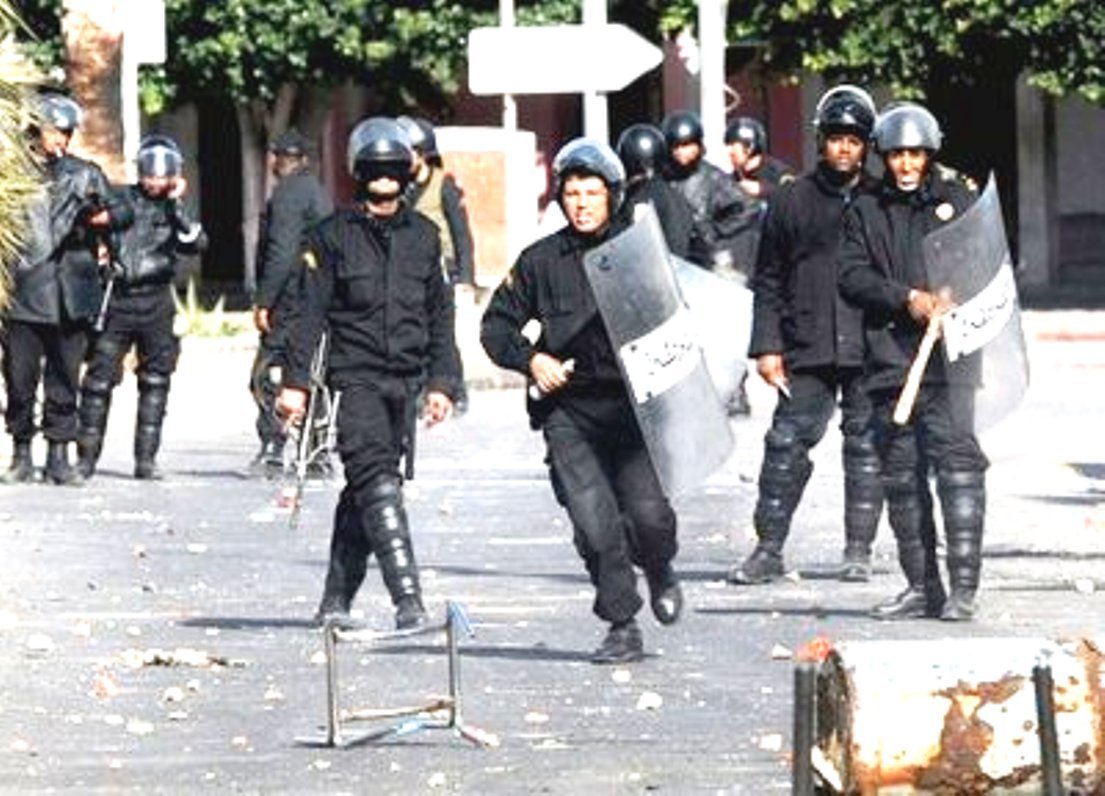
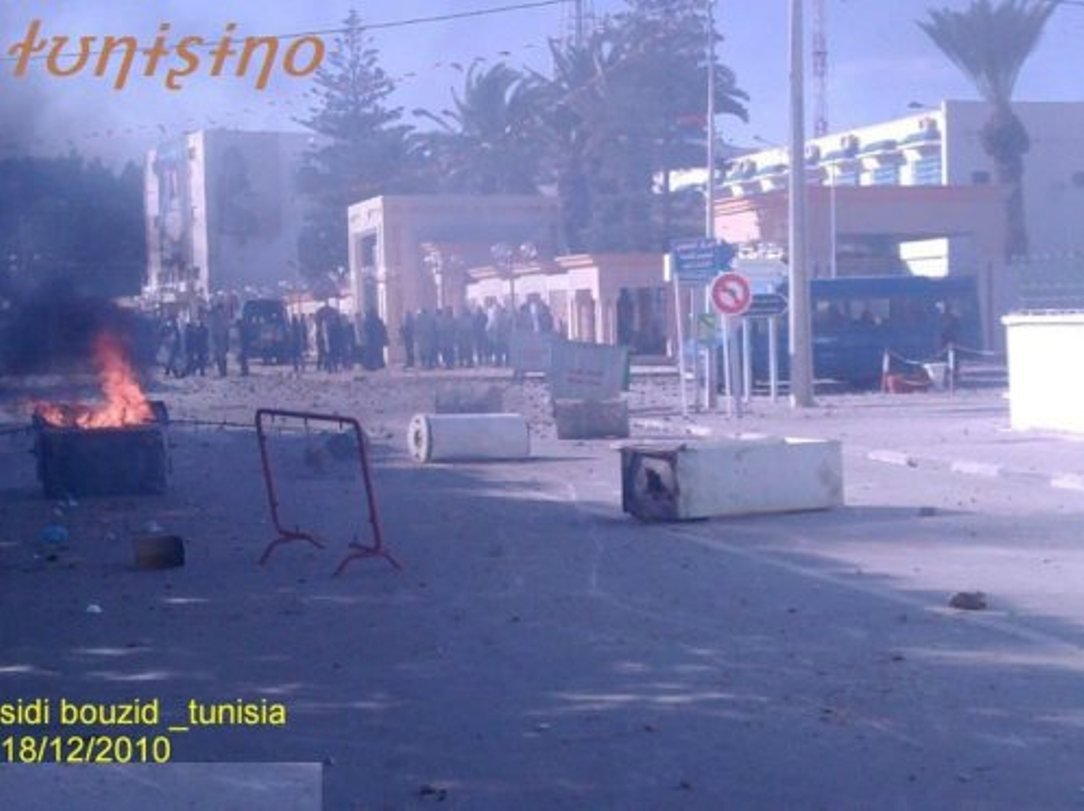
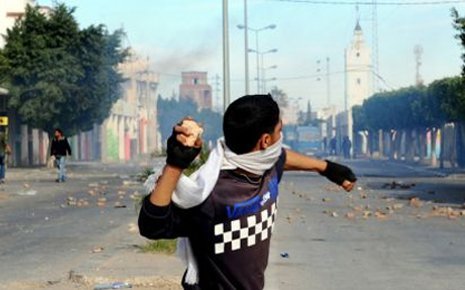
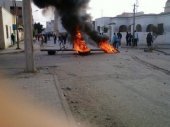
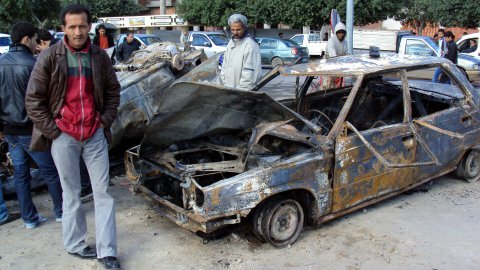
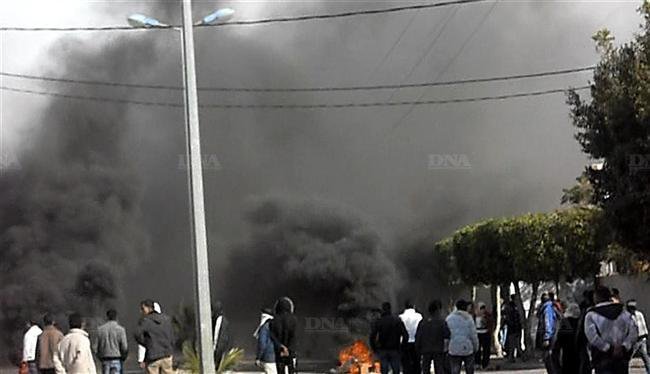
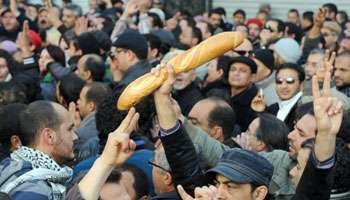
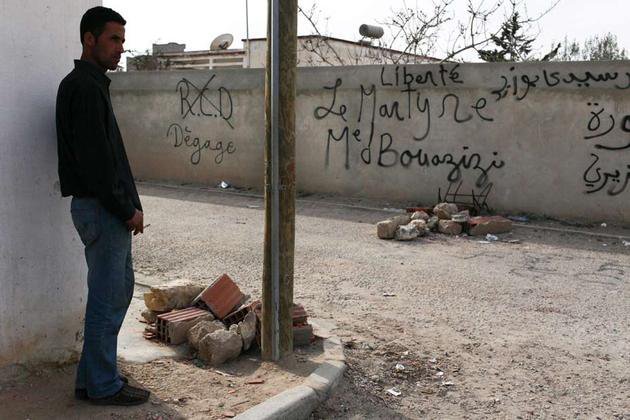
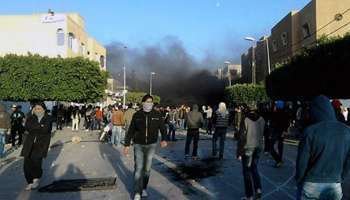
Memories from the ‘revolution'
21st Jun 2013
Ridha is a police officer in Sidi Bouzid, Tunisia. His personal car was torched, along with an official police vehicle, outside the central police station, after two people, Adel Hammami and Ridha Baccari, died in their prison cells on Feb 4 2011. Only three weeks after the ‘revolution,’ it became more 'acceptable,’ or at least common, to burn cars. In this interview, Ridha reflects on having his car destroyed.
He now takes public transportation for his daily 80km commute to work.
21st Jun 2013
a fire in a prison cell a fire outside
Three weeks after 14 Jan 2011 when Ben Ali’s regime fell - in the small town of Sidi Bouzid that ignited the uprising, there was a fire in a prison cell of two young men. Adel Hammami and Ridha Baccari burned to death. The details are fuzzy. One was arrested for being intoxicated, the other for something to do with falsifying documents. There was a fire where they both died….
People rebelled. How was it possible that two men died in their prison cell under the custody of the police? The atmosphere in the aftermath of the revolution, with so many unknowns, contributed to the rebellion. An official police car was burned, and a personal vehicle of an officer. The personal vehicle in the far back is pictured below, over two years later, sitting in a dump.
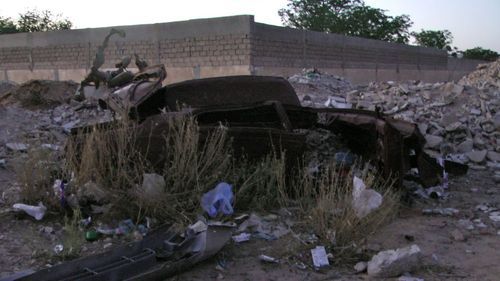
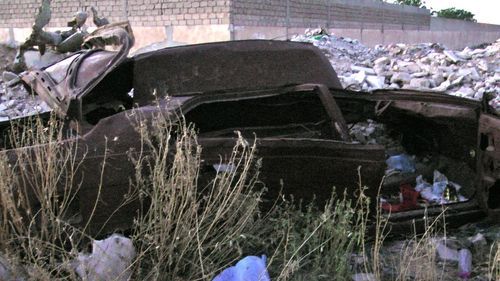
Four police officers were arrested for the deaths of Hammami and Baccari. Two of them pleaded guilty, Nafti Ben Ammar Youssfi and Magtouf Hammami. Each received one year of prison for “involuntary manslaughter resulting from negligence and dereliction.”
27th May 2013
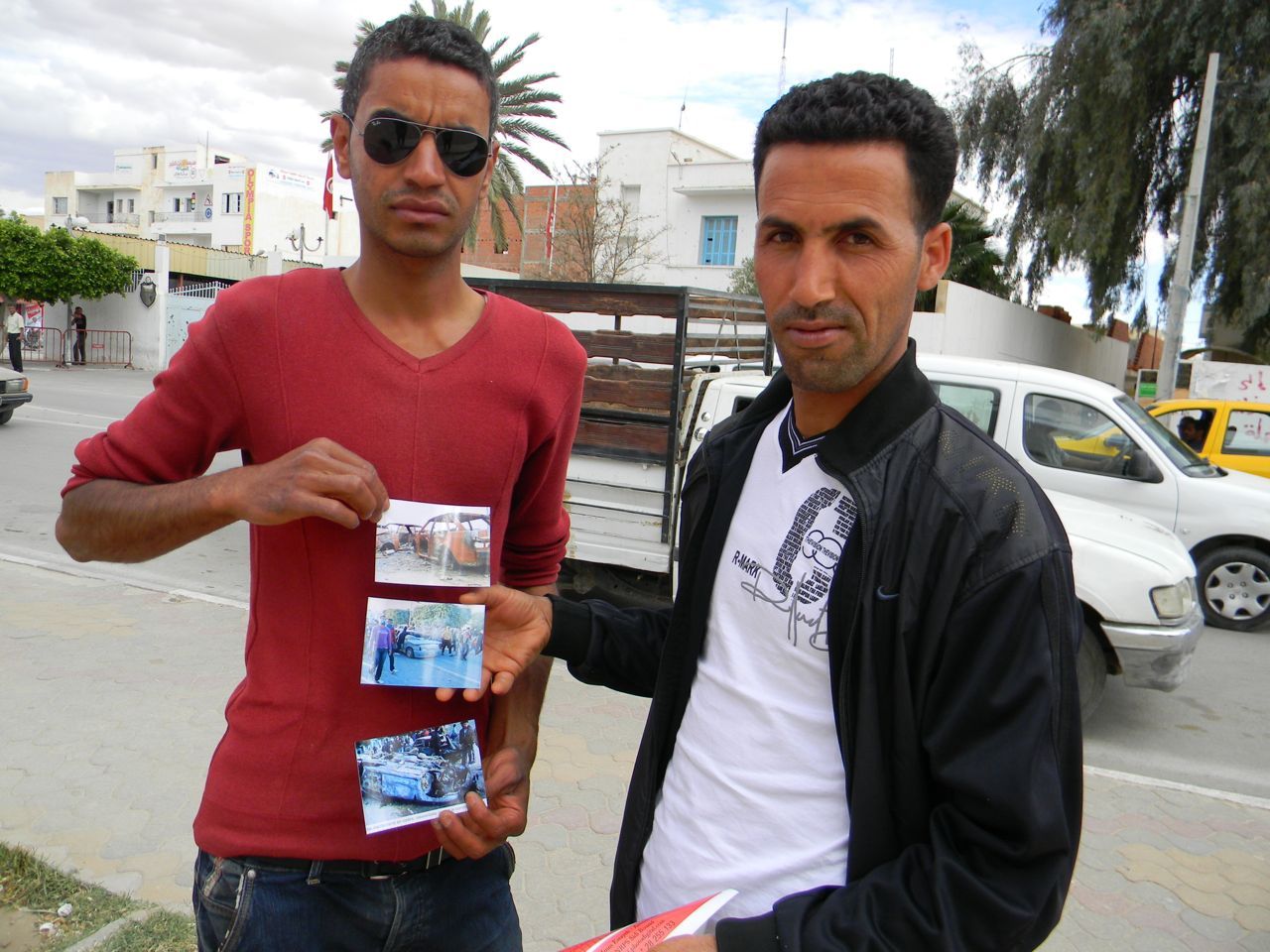
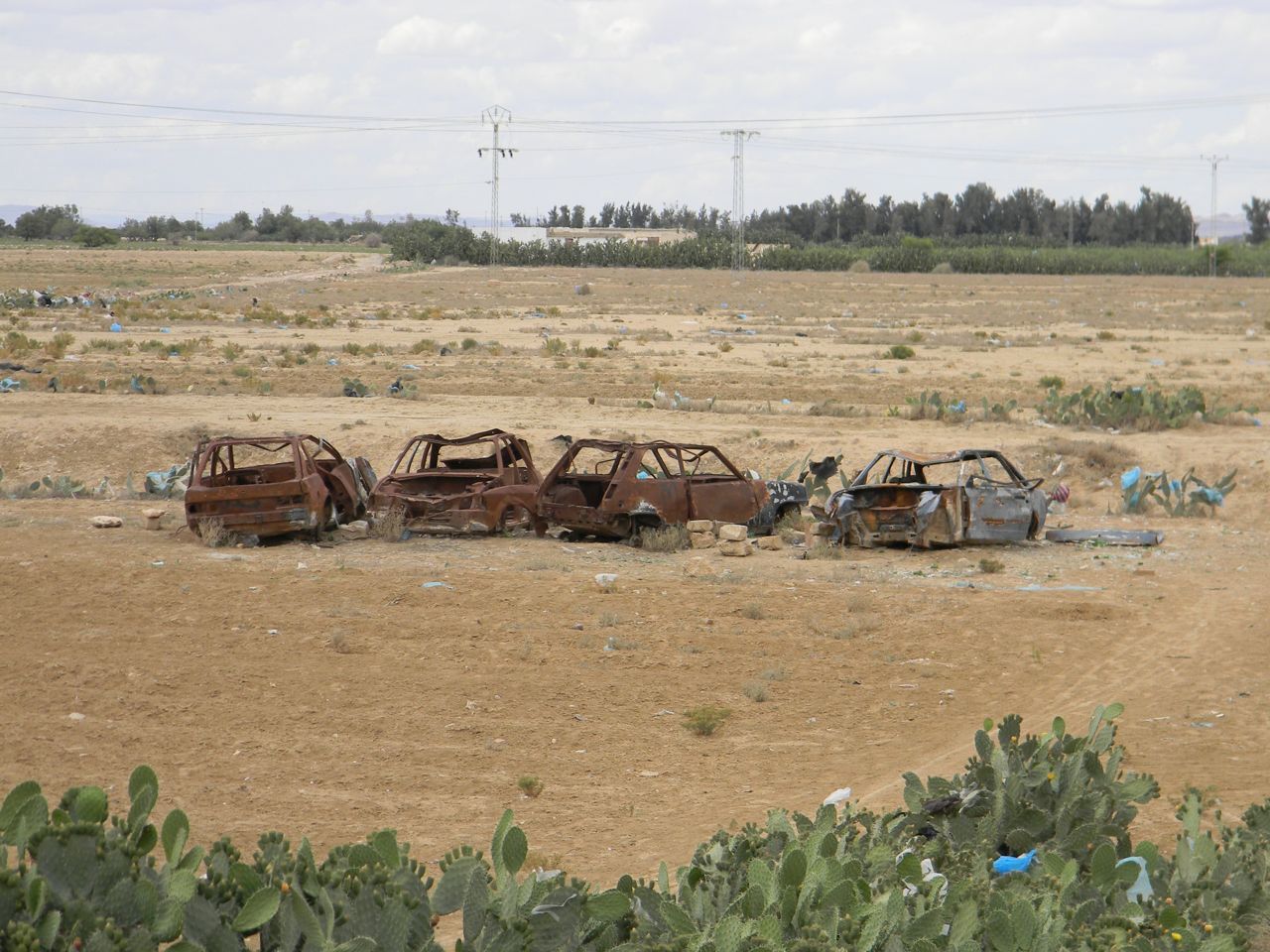
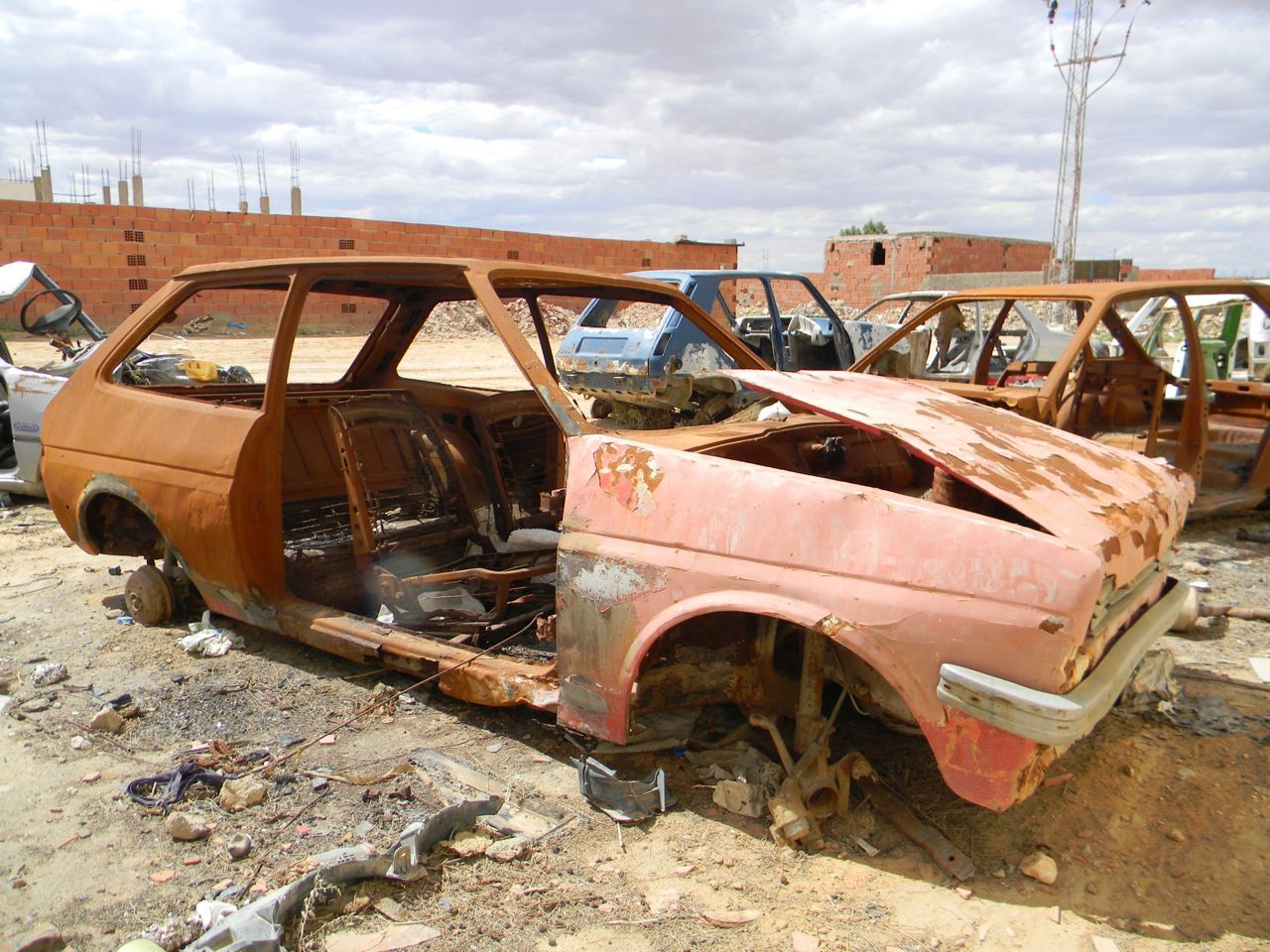
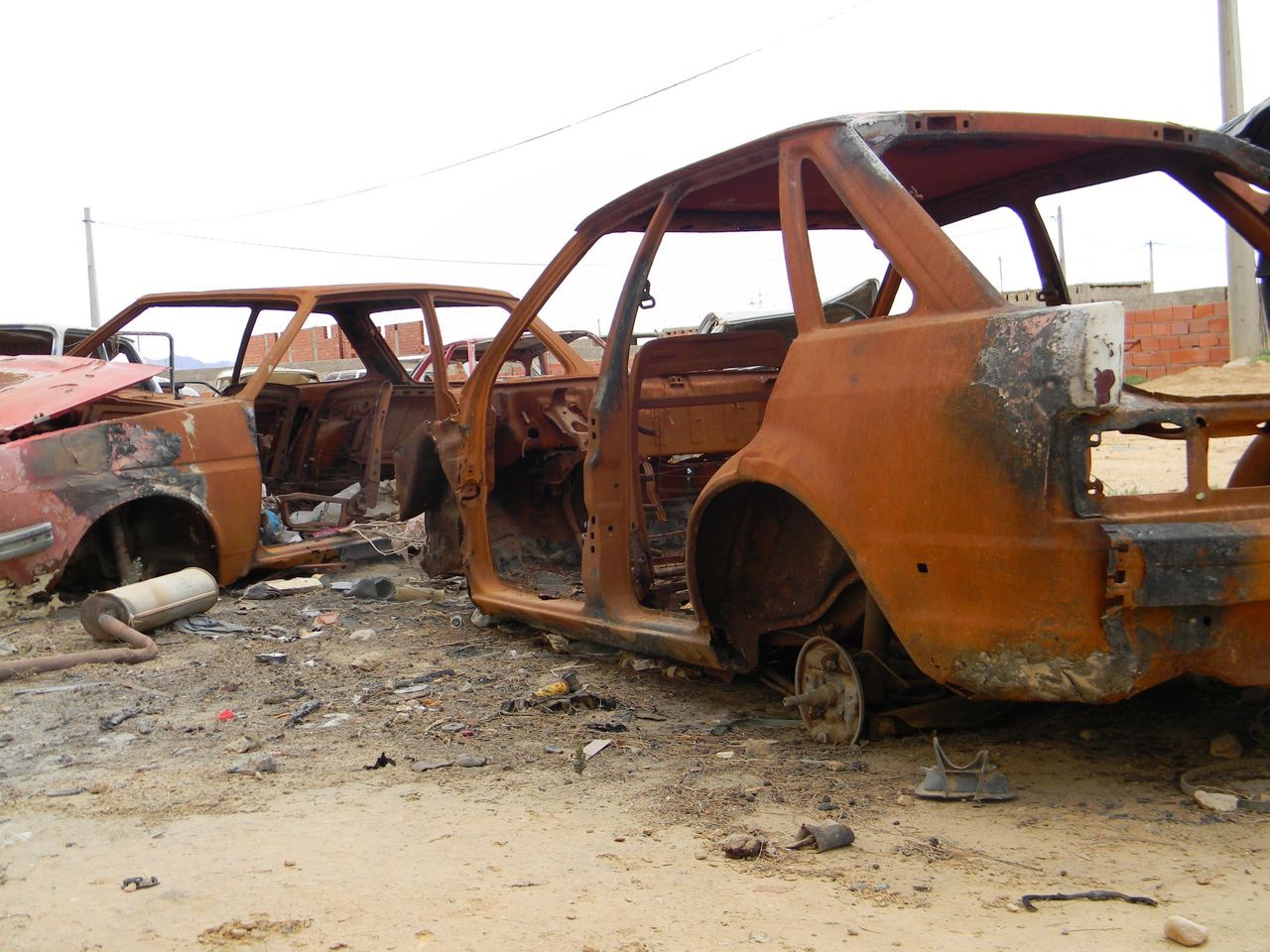
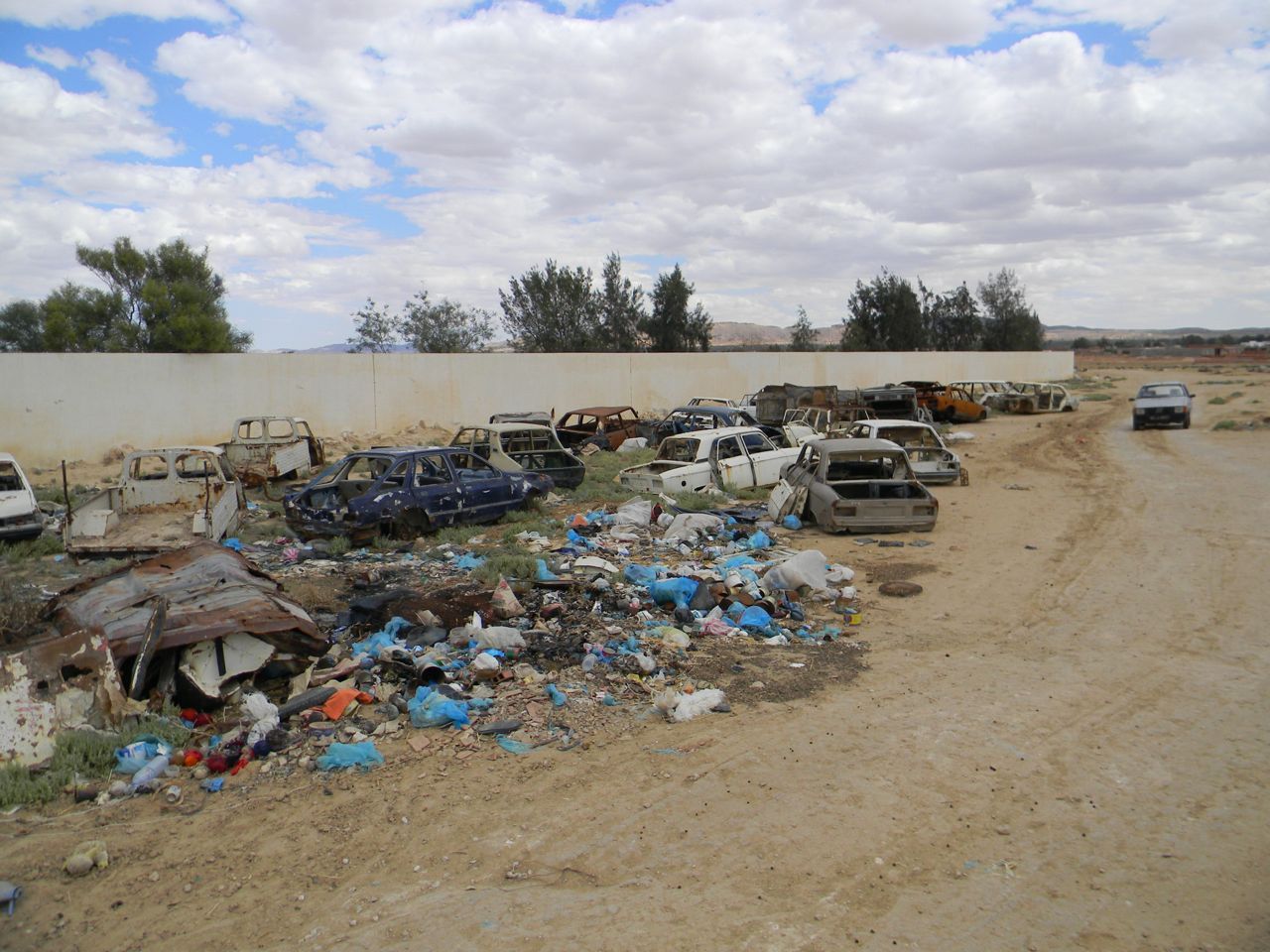
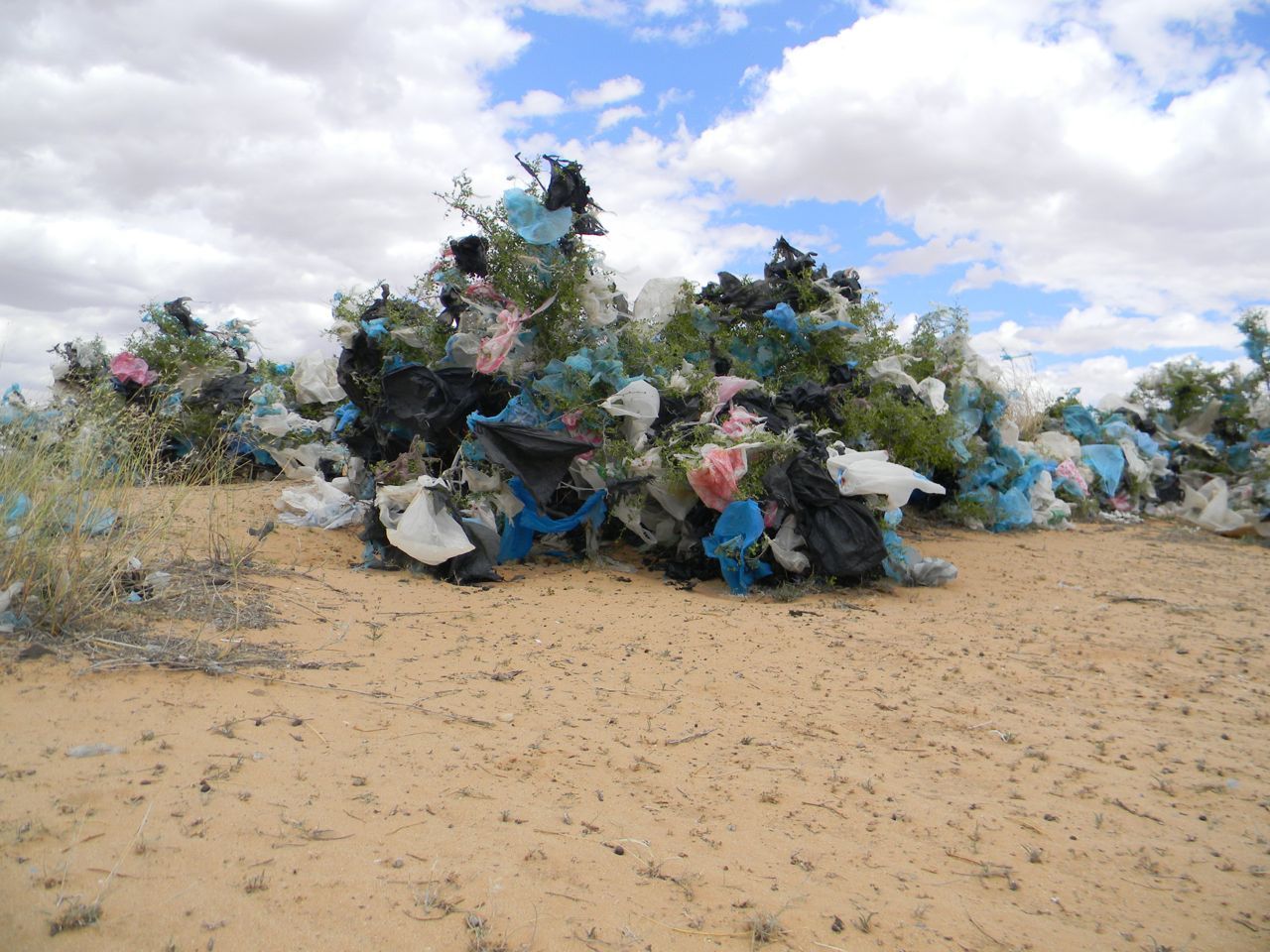
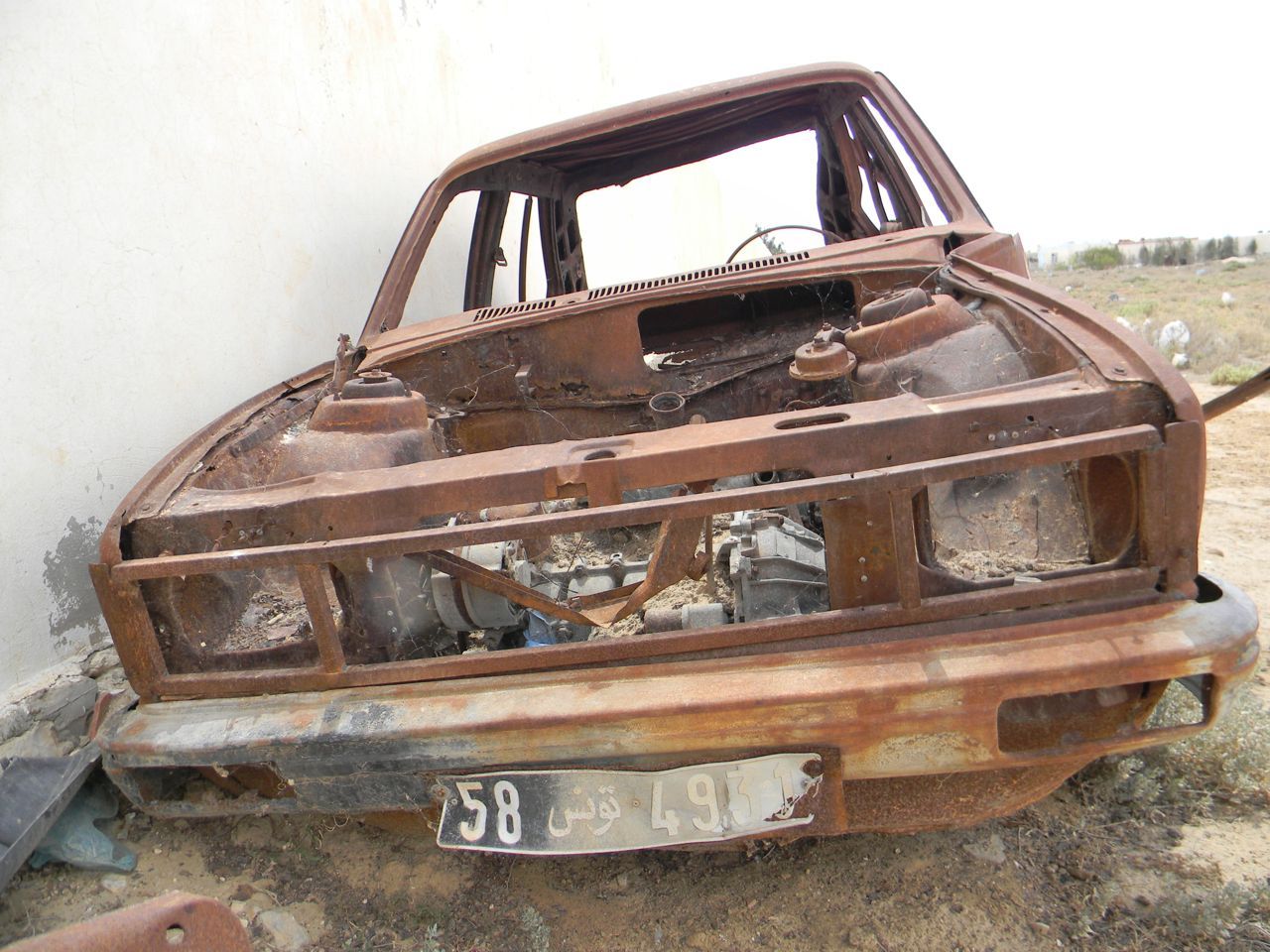
Where do dead cars go? Is there Car heaven?
Where the trees grow with plastic, and eyes don’t want to look.
Maybe when the city knows no one will pay for them at the Fourier Municipal, the city lot, they get dumped here - or there - the landscape is forgiving.
Maybe burned in an accident, maybe from revolutionary youth expressing their anger. More than 2 years after the fact, its difficult to identify which car is from which event - but Sidi Bouzid is a small town.
We have photos from the day of the protest when the first car was set on fire. Now we collect stories from this collective memory.
27th May 2013
More fire. Torched cars.
Mobs of people. Police station.
State institutions the source of their repression.
Fire.
Just another night in uprising..in this small town, Sidi Bouzid, which put more fire in the social unrest already waiting to explode
like a car lit on fire, waiting to be extinguished.
27th May 2013
Smells like revolution?
Or gas from Algeria or Libya, where diesel, cigarettes, electronics and lots more are smuggled across the borders because….
This limo belonged to the brother in law of Ben Ali.
27th May 2013
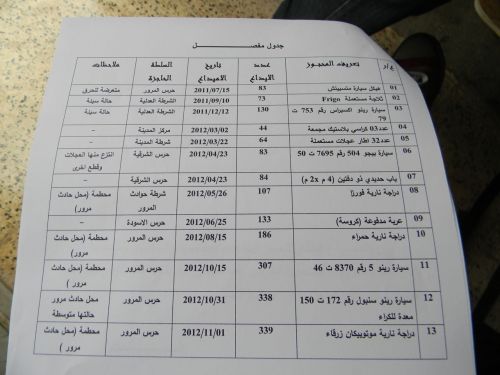
The municipality of Sidi Bouzid produced this list of cars - some immediately from the aftermath of clashes with authorities. Most of these cars sit here for months because, like most municipal parking lots, there are daily fees the owner must then reimburse the city for. A wrecked car is sometimes just too expensive to fix, especially with the ‘parking fees.’
23rd May 2013
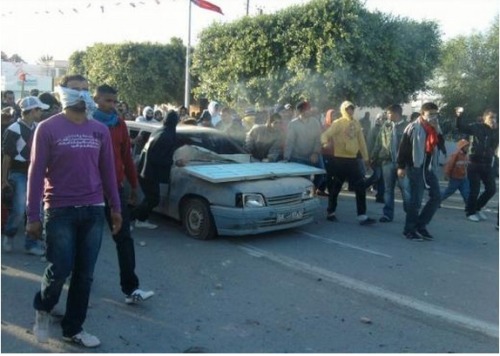
This was the first car burned in Sidi Bouzid. It belonged to the municipality, and taken to the front of the police station to be burned…. more details about how, why and where it is today, soon…
23rd May 2013
Nawaat Car
This was the first car burned in Sidi Bouzid. It belonged the municipality and it was taken to the front of the police station to be burned…. more details about how, why and where it is today soon.
20th May 2013
Fourier Municipal, Sidi Bouzid
Lost + Found.Burned + Extinguished. Violence on the streets and then locked behind big doors.
Over 15 cars were burned or smashed in the aftermath of Bouazizi’s self immolation, in Sidi Buzid, says the man who guards the municipality parking lot. This is the remains, tied up in bureaucracy, artifacts of upheaval..
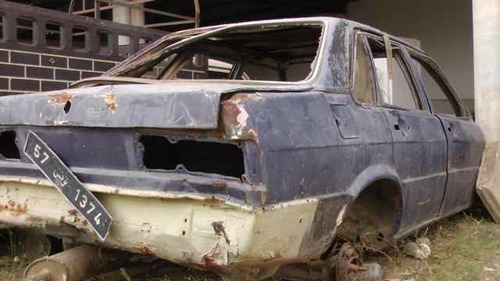
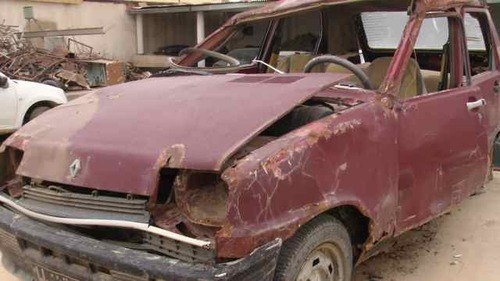
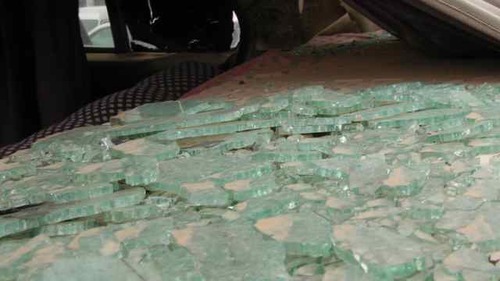
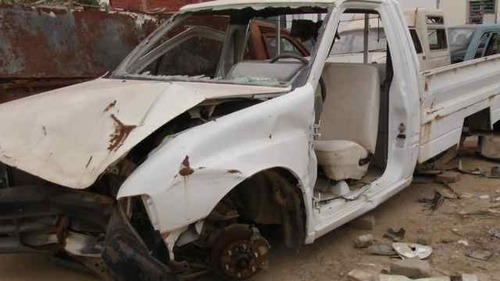
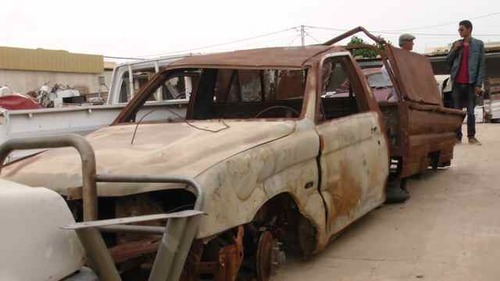
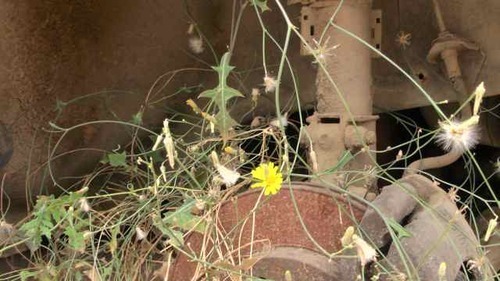
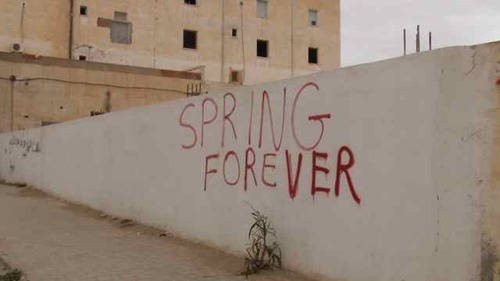
14th May 2013
Trabelssi Residence, Gammarth supérieur, Tunis
Another burned car, in the same place where it was torched, a fancy home overlooking the sea. A home of family of the wife of President Ben Ali, Leila Trabelssi, has been turned into a graffiti haven - a trashed space for anyone; to gather, to shoot music videos, to be taboo, re-appropriated by the community…
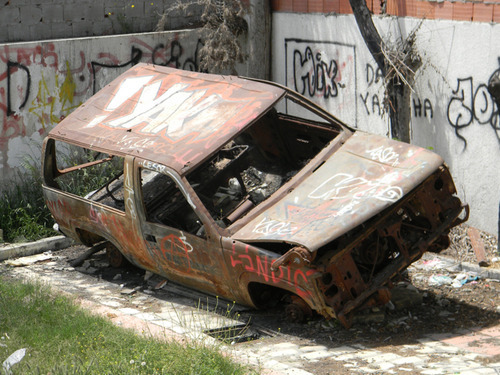
We, like most of Tunisia, do not know the whereabouts of the Trabelssi family, so getting permission for this vehicle to be moved to Munich will be challenging.
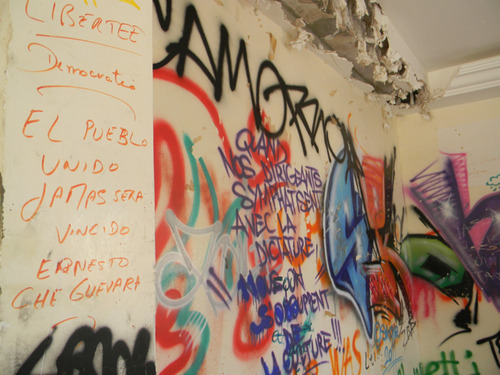
A quote from Che Guevara, “The people, united, will never be defeated”
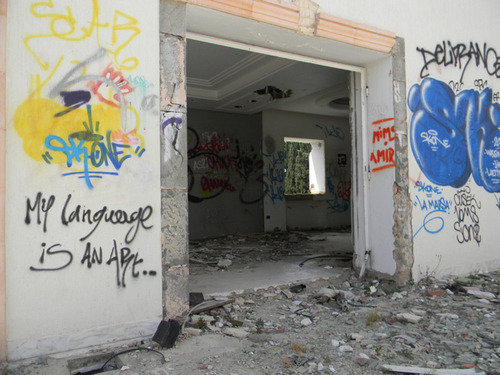
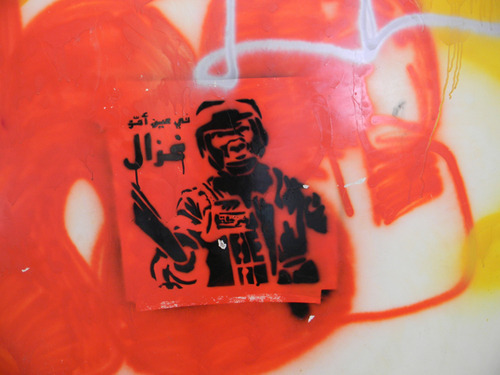
“In the eyes of his mother, he is a ‘Gazel’” (A reference meaning, 'a beauty’, but written on his uniform he is a cop, with a batton…)
14th May 2013
Douar Hicher, Tunis
A bus burned from protests in the aftermath of the assassination of Chokri Belaid. A Tunisian man, Ali, who has spent time in Germany, was happy to help bring a piece of Tunisia to Munich…. but when we arrived the bus had already been cut into pieces. Below are photos of the yard where the bus stood, before its metal found a new home…
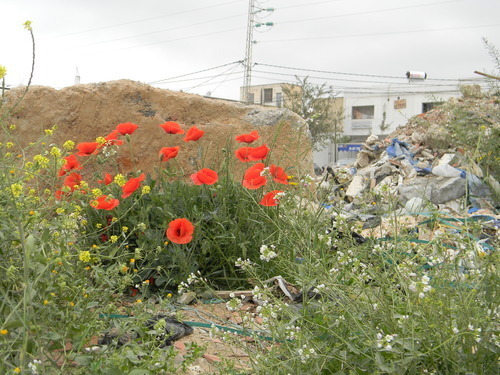
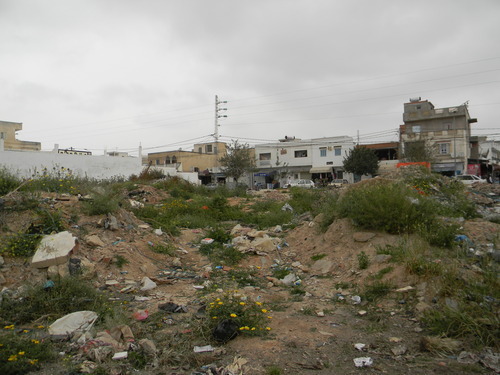
30th Apr 2013
stories, photos, videos - realities. a burned car as an artifact of uprising.
“Smell of revolution” is a artproject of Christian Schnurer and Tamar Maya Sharabi . We search a burned-out car wreck in order to bring it to the must fancy shopping streets of Central Europe.
The ready made relic of the democratic “revolution” in Tunisia becomes a work of art through the process of reversing the export path. The path through public space - input (or lack there of) with authorities is documented with sound and film recordings.
In Munich, the object becomes surreal event - forming a maximum contrast to the decadent environment, especially in the Maximilian Strasse, the destination for the cultured establishment. Unlike Berlin, Paris, London or Cairo cars burn very rare here.
The revolution is distant and strange. The realities of daily survival of systemic change and the ongoing struggle for a contract enabled Constitution and personal freedom disappears.
Unterstützt und gefördert durch:
das Kulturreferat der LH München - Projektzeitraum Sommer 2013


